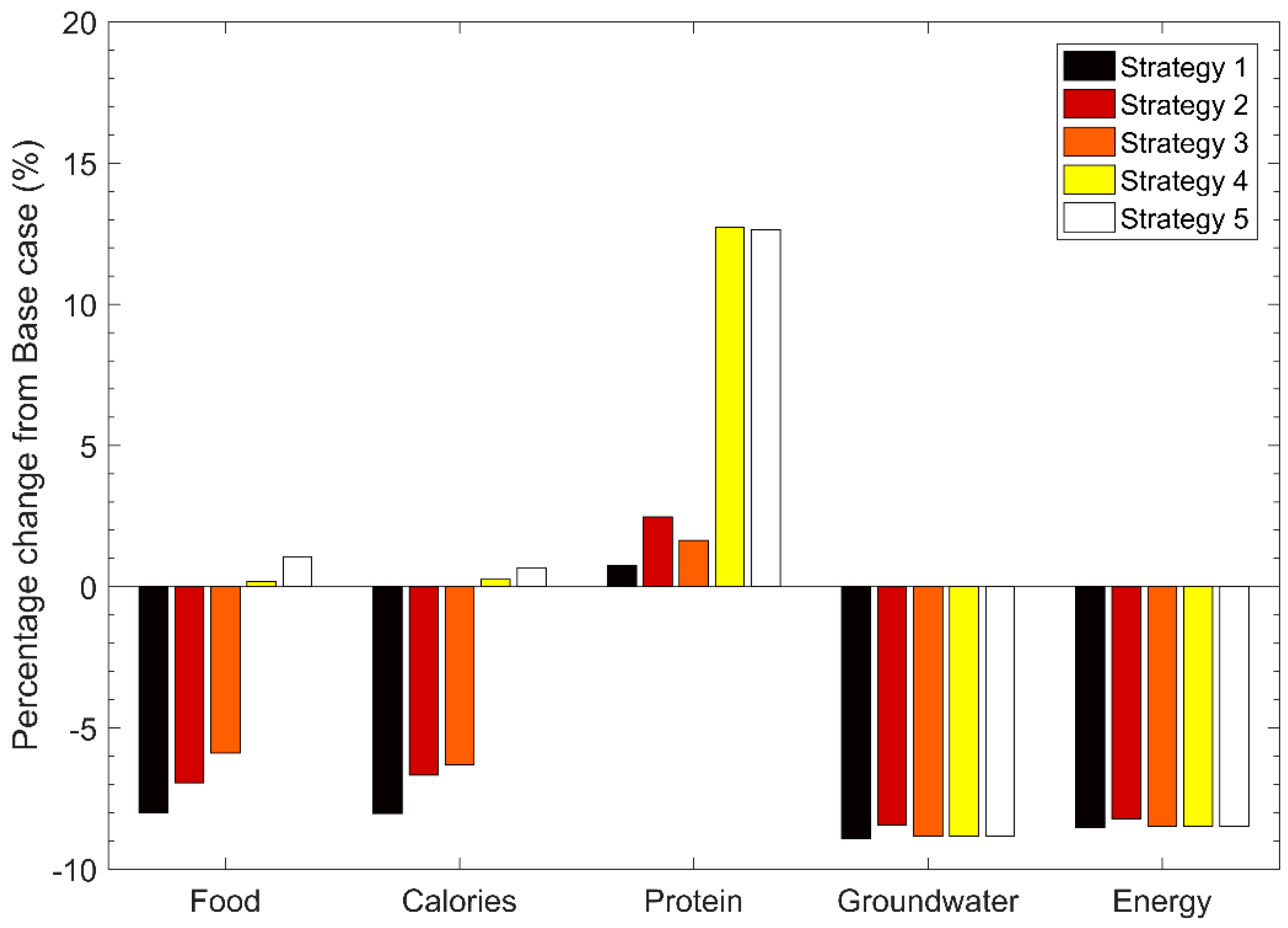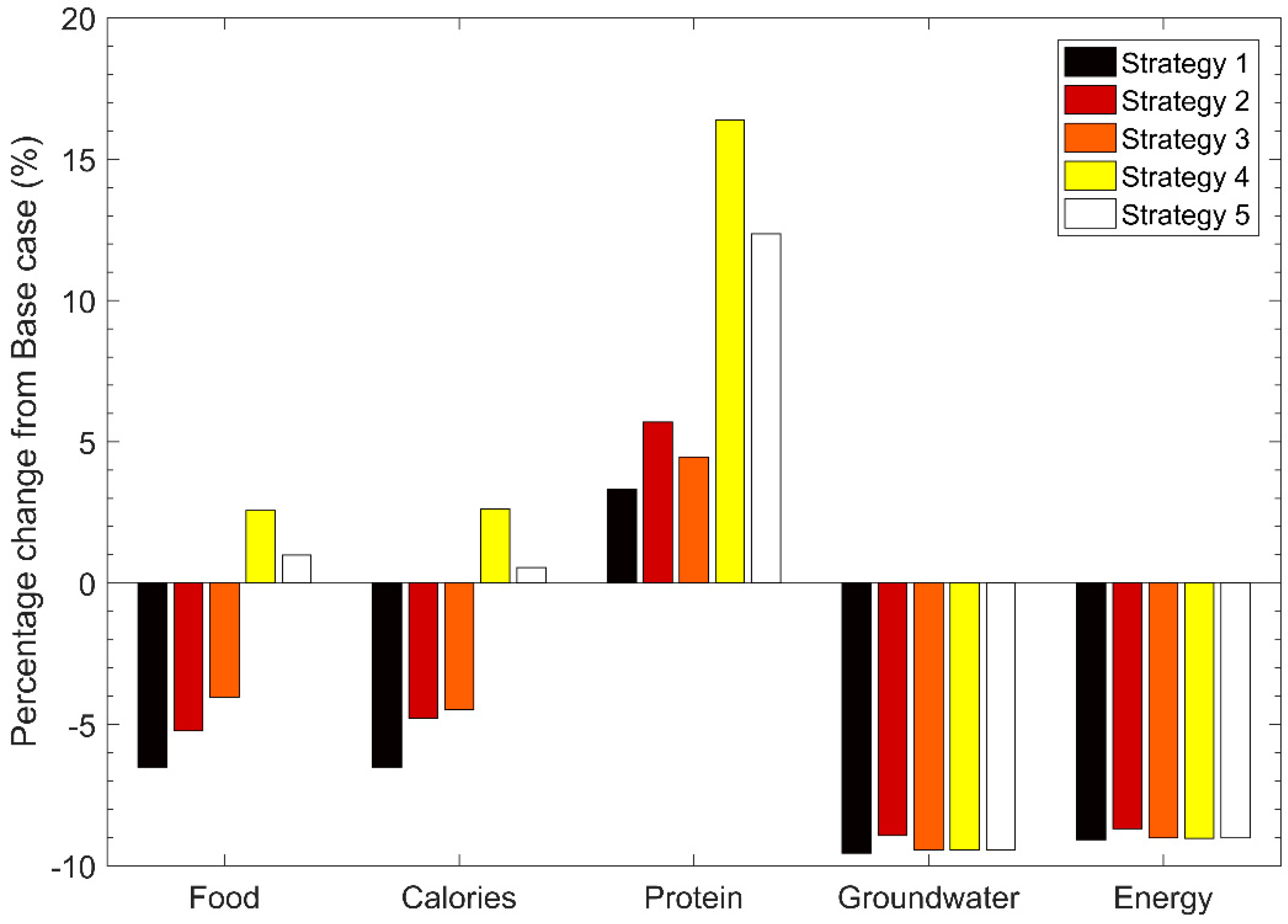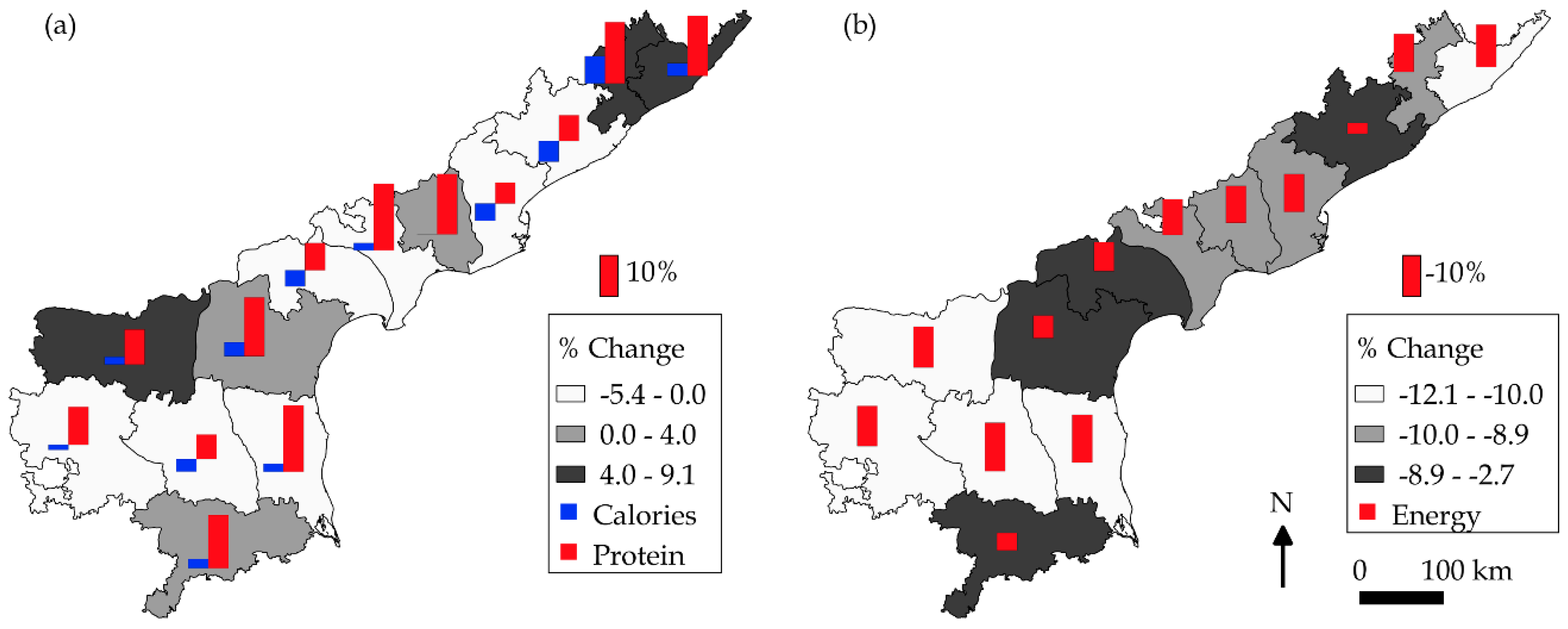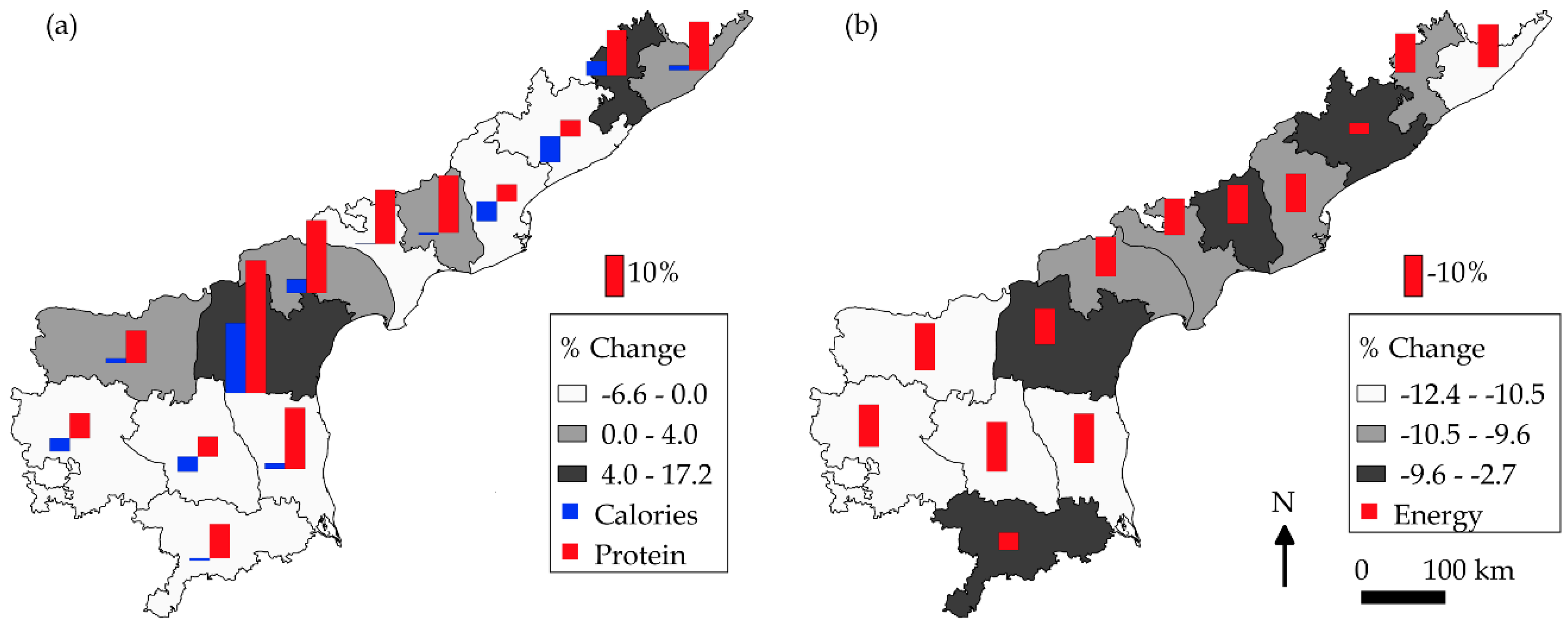Sustainable Intensification of Agriculture in the Context of the COVID-19 Pandemic: Prospects for the Future
Abstract
1. Introduction
2. Methodology
2.1. Estimating Crop Water Requirement
2.2. Evaluating Crop Diversification Strategies
- Equal distribution
- Proportionate distribution
- Crop-ranking distribution based on average yield
- Crop-ranking distribution based on maximum yield
- Crop-ranking distribution based on a modified average yield
3. Results and Discussion
3.1. Irrigation Water Requirement
3.2. Crop Diversification
4. Future Perspectives and Conclusions
Author Contributions
Funding
Conflicts of Interest
References
- Dasgupta, D.; Rajeev, M. Paradox of a Supply Constrained Keynesian Equilibrium. Econ. Political Wkly. 2020, 55, 23. [Google Scholar]
- Food and Agriculture Organization. Available online: http://www.fao.org/2019-ncov/q-and-a/impact-on-food-and-agriculture/en/ (accessed on 5 May 2020).
- United Nations. Available online: https://news.un.org/en/story/2020/04/1062272 (accessed on 14 May 2020).
- Business Standard India Labour Issues: Punjab to Promote Maize Cultivation in Coming Kharif Season. Available online: https://www.business-standard.com/article/economy-policy/labour-issues-punjab-to-promote-maize-cultivation-in-coming-kharif-season-120041900798_1.html (accessed on 9 May 2020).
- IMF World Economic Outlook, April 2020: The Great Lockdown. Available online: https://www.imf.org/en/Publications/WEO/Issues/2020/04/14/weo-april-2020 (accessed on 5 May 2020).
- ICRISAT Containing COVID19 impacts on Indian Agriculture—ICRISAT. Available online: https://www.icrisat.org/containing-covid19-impacts-on-indian-agriculture/ (accessed on 5 May 2020).
- Subramanian, A.; Felman, J. India’s Great Slowdown. Available online: https://www.hks.harvard.edu/centers/cid/publications/faculty-working-papers/india-great-slowdown (accessed on 1 June 2020).
- Sen, A. Food, economics and entitlements. Political Econ. Hunger 1990, 1, 34–50. [Google Scholar]
- UN World Population Prospects—Population Division—United Nations. Available online: https://population.un.org/wpp/ (accessed on 5 May 2020).
- Shah, T.; Scott, C.; Kishore, A.; Sharma, A. Energy-Irrigation Nexus in South Asia: Improving Groundwater Conservation and Power Sector Viability; International Water Management Institute: Colombo, Sri Lanka, 2004; Volume 70. [Google Scholar]
- Tilman, D.; Balzer, C.; Hill, J.; Befort, B.L. Global food demand and the sustainable intensification of agriculture. Proc. Natl. Acad. Sci. USA 2011, 108, 20260–20264. [Google Scholar] [CrossRef] [PubMed]
- Aeschbach-Hertig, W.; Gleeson, T. Regional strategies for the accelerating global problem of groundwater depletion. Nat. Geosci. 2012, 5, 853–861. [Google Scholar] [CrossRef]
- Scanlon, B.R.; Mukherjee, A.; Gates, J.; Reedy, R.C.; Sinha, A.K. Groundwater recharge in natural dune systems and agricultural ecosystems in the Thar Desert region, Rajasthan, India. Hydrogeol. J. 2010, 18, 959–972. [Google Scholar] [CrossRef]
- Famiglietti, J.S. The global groundwater crisis. Nat. Clim. Chang. 2014, 4, 945–948. [Google Scholar] [CrossRef]
- Phalan, B.; Green, R.E.; Dicks, L.V.; Dotta, G.; Feniuk, C.; Lamb, A.; Strassburg, B.B.; Williams, D.R.; Zu Ermgassen, E.K.; Balmford, A. How can higher-yield farming help to spare nature? Science 2016, 351, 450–451. [Google Scholar] [CrossRef]
- Willett, W.; Rockström, J.; Loken, B.; Springmann, M.; Lang, T.; Vermeulen, S.; Garnett, T.; Tilman, D.; DeClerck, F.; Wood, A.; et al. Food in the Anthropocene: The EAT–Lancet Commission on healthy diets from sustainable food systems. Lancet 2019, 393, 447–492. [Google Scholar] [CrossRef]
- Wada, Y.; van Beek, L.P.H.; Bierkens, M.F.P. Nonsustainable groundwater sustaining irrigation: A global assessment: Nonsustainable groundwater sustaining irrigation. Water Resour. Res. 2012, 48. [Google Scholar] [CrossRef]
- Blakeslee, D.; Fishman, R.; Srinivasan, V. Way Down in the Hole: Adaptation to Long-Term Water Loss in Rural India. Am. Econ. Rev. 2020, 110, 200–224. [Google Scholar] [CrossRef]
- Fishman, R. Running Out of Water, Walking Away from Farming. Available online: http://www.ideasforindia.in/topics/environment/running-out-of-water-walking-away-from-farming.html (accessed on 30 May 2020).
- Sachs, J.D. From millennium development goals to sustainable development goals. Lancet 2012, 379, 2206–2211. [Google Scholar] [CrossRef]
- Grigss, D. Sustainable developmnet goals for people and planet. Nature 2013, 495, 305–307. [Google Scholar] [CrossRef] [PubMed]
- FAO. Nutrition-sensitive Agriculture. In Proceedings of the Second International Conference on Nutrition, Rome, Italy, 19–21 November 2014; pp. 29–36. [Google Scholar] [CrossRef]
- Davis, K.F.; Rulli, M.C.; Seveso, A.; D’Odorico, P. Increased food production and reduced water use through optimized crop distribution. Nat. Geosci. 2017, 10, 919–924. [Google Scholar] [CrossRef]
- Giller, K.E.; Witter, E.; Corbeels, M.; Tittonell, P. Conservation agriculture and smallholder farming in Africa: The heretics’ view. Field Crops Res. 2009, 114, 23–34. [Google Scholar] [CrossRef]
- Ruel, M.T.; Quisumbing, A.R.; Balagamwala, M. Nutrition-sensitive agriculture: What have we learned so far? Glob. Food Secur. 2018, 17, 128–153. [Google Scholar] [CrossRef]
- Cassman, K.G.; Grassini, P. A global perspective on sustainable intensification research. Nat. Sustain. 2020, 3, 262–268. [Google Scholar] [CrossRef]
- Hunter, M.C.; Smith, R.G.; Schipanski, M.E.; Atwood, L.W.; Mortensen, D.A. Agriculture in 2050: Recalibrating targets for sustainable intensification. Bioscience 2017, 67, 386–391. [Google Scholar] [CrossRef]
- Government of India. Food and Nutrition Security Analysis. Available online: http://www.indiaenvironmentportal.org.in/files/file/Food%20and%20Nutrition%20Security%20Analysis.pdf (accessed on 5 May 2020).
- Kumar, A.; Tomer, V.; Kaur, A.; Kumar, V.; Gupta, K. Millets: A solution to agrarian and nutritional challenges. Agric. Food Secur. 2018, 7, 31. [Google Scholar] [CrossRef]
- Saxena, R.; Vanga, S.K.; Wang, J.; Orsat, V.; Raghavan, V. Millets for Food Security in the Context of Climate Change: A Review. Sustainability 2018, 10, 2228. [Google Scholar] [CrossRef]
- Davis, K.F.; Chhatre, A.; Rao, N.D.; Singh, D.; Ghosh-Jerath, S.; Mridul, A.; Poblete-Cazenave, M.; Pradhan, N.; DeFries, R. Assessing the sustainability of post-Green Revolution cereals in India. Proc. Natl. Acad. Sci. USA 2019, 116, 25034–25041. [Google Scholar] [CrossRef]
- Rawal, V.; Navarro, D.K. The Global Economy of Pulses; FAO: Rome, Italy, 2019; p. 190. [Google Scholar]
- Awika, J.M. Major Cereal Grains Production and Use around the World. In Advances in Cereal Science: Implications to Food Processing and Health Promotion; Awika, J.M., Piironen, V., Bean, S., Eds.; American Chemical Society: Washington, DC, USA, 2011; Volume 1089, pp. 1–13. ISBN 978-0-8412-2636-4. [Google Scholar]
- OECD Never Let A Good Water Crisis Go To Waste—OECD. Available online: https://www.oecd.org/agriculture/never-waste-a-good-water-crisis/ (accessed on 8 May 2020).
- Satpathi, S.; Saha, A.; Basu, S. Millets as a Policy Response to the Food and Nutrition Crisis—Special Reference to the Odisha Millets Mission. Available online: https://www.brlf.in/brlf2/wp-content/uploads/2020/01/Odisha-Millet-Mission.pdf (accessed on 30 May 2020).
- Government of Andhra Pradesh. India Comprehensive Revival of Millets Program (Cmrp)—Andhra Pradesh. Available online: https://www.wassan.org/Millets.htm (accessed on 1 June 2020).
- Clarke, D.; Smith, M.; El-Askari, K. CropWat for Windows: User Guide. Available online: http://www.fao.org/land-water/databases-and-software/cropwat/en/ (accessed on 6 May 2020).
- Government of Andhra Pradesh. India Agricultural Statistics At A Glance 2017–18. Available online: https://core.ap.gov.in/CMDashBoard/Download/Publications/ASAG-%202017-18.pdf (accessed on 6 May 2020).
- Government of Andhra Pradesh. India Socio-Economic Survey 2018–19, Government of Andhra Pradesh. Available online: https://www.apfinance.gov.in/downloads/SocioEconomicalSurvey2018-19.pdf (accessed on 1 June 2020).
- Suryanarayana, M.H.; Agrawal, A.; Prabhu, K.S. Inequality-adjusted Human Development Index for India’s States. Available online: https://www.undp.org/content/dam/india/docs/inequality_adjusted_human_development_index_for_indias_state1.pdf (accessed on 1 June 2020).
- Government of Andhra Pradesh, India. Available online: https://core.ap.gov.in/CMDashBoard/UserInterface/EconomicsandStatistics/AgricultureStatisticsReport.aspx (accessed on 6 May 2020).
- IMD Long Range ForecastFor the 2020 Southwest Monsoon Season Rainfall. Available online: https://mausam.imd.gov.in/Forecast/marquee_data/1st_Stage_LRF_apr_2020_English.pdf (accessed on 12 May 2020).
- APWRIMS. Available online: http://www.apwrims.ap.gov.in/ (accessed on 6 May 2020).
- India Water Portal Meteorological Datasets. Available online: https://www.indiawaterportal.org/met_data/ (accessed on 6 May 2020).
- Tribune India Wheat Procurement 18.35 per cent Less Than Last Year. Available online: https://www.tribuneindia.com/news/nation/wheat-procurement-18-35-per-cent-less-than-last-year-82196 (accessed on 9 May 2020).
- Davis, K.; Seveso, A.; Rulli, M.; D’Odorico, P. Water Savings of Crop Redistribution in the United States. Water 2017, 9, 83. [Google Scholar] [CrossRef]
- Government of Andhra Pradesh, India. Available online: https://core.ap.gov.in/CMDashBoard/userinterface/groundwater/groundwaterreports.aspx (accessed on 7 May 2020).
- Government of Andhra Pradesh. India White paper on Agriculture, Horticulture, Animal Husbandry, Sericulture, Dairy Development, Fisheries, Agricultural Marketing Departments. Available online: https://www.ap.gov.in/wp-content/uploads/2018/12/White-paper-on-Agriculture-Horticulture-Animal-Husbandry-Sericulture-Dairy-Development-Fisheries-Agricultural-Marketing-Departments.pdf (accessed on 1 June 2020).
- Jain, M.; Solomon, D.; Capnerhurst, H.; Arnold, A.; Elliott, A.; Kinzer, A.; Knauss, C.; Peters, M.; Rolf, B.; Weil, A.; et al. How much can sustainable intensification increase yields across South Asia? A systematic review of the evidence. Environ. Res. Lett. 2020, 15. [Google Scholar] [CrossRef]
- Davis, K.F.; Gephart, J.A.; Emery, K.A.; Leach, A.M.; Galloway, J.N.; D’Odorico, P. Meeting future food demand with current agricultural resources. Glob. Environ. Chang. 2016, 39, 125–132. [Google Scholar] [CrossRef]
- Kayatz, B.; Harris, F.; Hillier, J.; Adhya, T.; Dalin, C.; Nayak, D.; Green, R.F.; Smith, P.; Dangour, A.D. “More crop per drop”: Exploring India’s cereal water use since 2005. Sci. Total Environ. 2019, 673, 207–217. [Google Scholar] [CrossRef] [PubMed]





| Crop | Area under Cultivation (′000 ha) | Percentage Irrigated by Groundwater (%) |
|---|---|---|
| Maize | 106.8 | 20.7 |
| Paddy | 1477.7 | 14.7 |
| Bengal gram | 0.3 | 4.3 |
| Black gram | 44.2 | 12.7 |
| Green gram | 14.3 | 9.1 |
| Horse gram | 24.1 | 0.5 |
| Red gram | 266.4 | 2.2 |
| Bajra (pearl millet) | 40.2 | 19.2 |
| Jowar (sorghum) | 40.8 | 3.5 |
| Ragi (finger millet) | 26.9 | 1.8 |
| Groundnut | 673.2 | 4.9 |
| Chilies | 87.3 | 35.4 |
| Cotton | 644.5 | 5.9 |
| Sugarcane | 98.8 | 41.4 |
| Crop | Average Yield (kg ha−1) | Energy (kcal kg−1) | Protein (g kg−1) |
|---|---|---|---|
| Maize | 3764.7 | 3008.3 | 72.7 |
| Paddy | 4073.7 | 3695.4 | 69.5 |
| Bengal gram | 1322.5 | 3320 | 212 |
| Black gram | 856.6 | 3160 | 239 |
| Green gram | 644.0 | 3250 | 209 |
| Horse gram | 269.2 | 3090 | 253 |
| Red gram | 595.1 | 3060 | 206 |
| Bajra (pearl millet) | 1738.3 | 3630 | 114 |
| Jowar (sorghum) | 1294.9 | 3290 | 108.2 |
| Ragi (finger millet) | 959.3 | 3340 | 74.4 |
| Groundnut | 1658.2 | 5373.8 | 230.4 |
| Crop | Range of Irrigation Water Requirement (mm) | Average Irrigation Water Requirement (mm) |
|---|---|---|
| Maize | 9–320 | 117 |
| Paddy | 153–1037 | 478 |
| Bengal gram | 3–387 | 150 |
| Black gram | 0–225 | 97 |
| Green gram | 3–290 | 102 |
| Horse gram | 14–206 | 109 |
| Red gram | 3–216 | 88 |
| Bajra (pearl millet) | 0–235 | 77 |
| Jowar (sorghum) | 0–294 | 85 |
| Ragi (finger millet) | 0–235 | 39 |
| Groundnut | 0–400 | 135 |
| Chilies | 20–232 | 127 |
| Cotton | 35–490 | 266 |
| Sugarcane | 554–1471 | 1039 |
| District | Total Groundwater Consumption (mm3) |
|---|---|
| Ananthapur | 118.2 |
| Chittoor | 335.8 |
| East Godavari | 84.9 |
| Guntur | 104.3 |
| Krishna | 143.9 |
| Kurnool | 220.0 |
| Prakasam | 111.1 |
| S.P.S. Nellore | 425.4 |
| Srikakulam | 17.1 |
| Visakhapatnam | 81.7 |
| Vizianagaram | 32.2 |
| West Godavari | 374.9 |
| Y.S.R. Kadapa | 191.1 |
| Total | 2240.6 |
| Scenario | Strategy | Food (million tons) | Energy (1012 kCal) | Protein (1011 g) | Groundwater (billion m3) | Energy (GW h) |
|---|---|---|---|---|---|---|
| A | - | 1.30 | 4.81 | 1.05 | 2.24 | 119.9 |
| B | 1 | 1.19 | 4.42 | 1.05 | 2.04 | 109.7 |
| 2 | 1.21 | 4.49 | 1.07 | 2.05 | 110.1 | |
| 3 | 1.22 | 4.50 | 1.06 | 2.04 | 109.8 | |
| 4 | 1.30 | 4.82 | 1.18 | 2.04 | 109.8 | |
| 5 (K = 1.3) | 1.31 | 4.84 | 1.18 | 2.04 | 109.8 | |
| C | 1 | 1.21 | 4.49 | 1.08 | 2.03 | 109.0 |
| 2 | 1.23 | 4.58 | 1.11 | 2.04 | 109.5 | |
| 3 | 1.24 | 4.59 | 1.09 | 2.03 | 109.1 | |
| 4 | 1.33 | 4.93 | 1.22 | 2.03 | 109.1 | |
| 5 (K = 1.2) | 1.31 | 4.83 | 1.18 | 2.03 | 109.1 |
© 2020 by the authors. Licensee MDPI, Basel, Switzerland. This article is an open access article distributed under the terms and conditions of the Creative Commons Attribution (CC BY) license (http://creativecommons.org/licenses/by/4.0/).
Share and Cite
Sampath, P.V.; Jagadeesh, G.S.; Bahinipati, C.S. Sustainable Intensification of Agriculture in the Context of the COVID-19 Pandemic: Prospects for the Future. Water 2020, 12, 2738. https://doi.org/10.3390/w12102738
Sampath PV, Jagadeesh GS, Bahinipati CS. Sustainable Intensification of Agriculture in the Context of the COVID-19 Pandemic: Prospects for the Future. Water. 2020; 12(10):2738. https://doi.org/10.3390/w12102738
Chicago/Turabian StyleSampath, Prasanna Venkatesh, Gaddam Sai Jagadeesh, and Chandra Sekhar Bahinipati. 2020. "Sustainable Intensification of Agriculture in the Context of the COVID-19 Pandemic: Prospects for the Future" Water 12, no. 10: 2738. https://doi.org/10.3390/w12102738
APA StyleSampath, P. V., Jagadeesh, G. S., & Bahinipati, C. S. (2020). Sustainable Intensification of Agriculture in the Context of the COVID-19 Pandemic: Prospects for the Future. Water, 12(10), 2738. https://doi.org/10.3390/w12102738





